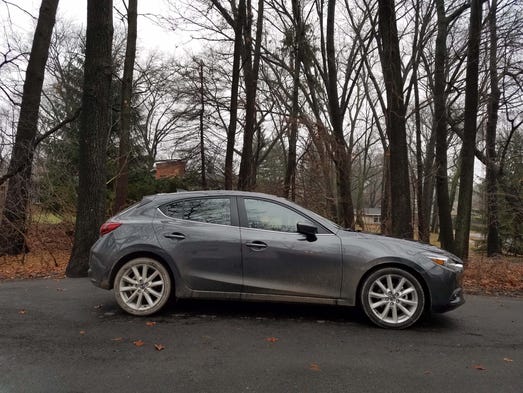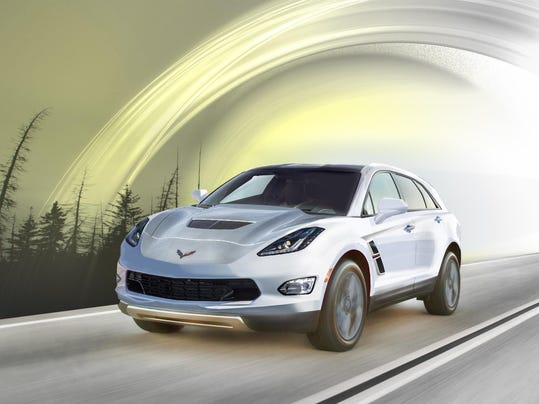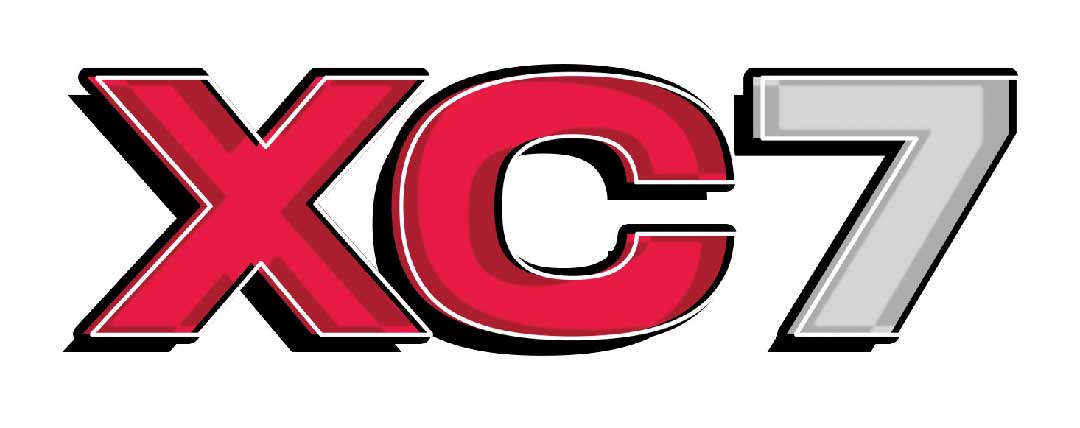Blog Editorial Cartoons
Cartoon: Taxes Next Year
Posted by hpayne on April 17, 2017
Cartoon: Trump Egg
Posted by hpayne on April 17, 2017
NY Auto Show: Payne’s top picks
Posted by hpayne on April 15, 2017

The New York Auto Show is North America’s most-attended: More than a million New Yorkers are expected to rush the Javits Convention Center’s gates from now through April 23.
They won’t be disappointed. This year’s show is a new-car feast with a menu longer than Carnegie Deli.
These are my favorites.
Dodge Challenger SRT Demon
This will be remembered as the Demon’s show. The smoke from its huge tires obscured every other reveal. The 840-horse dragster is for the enthusiast who finds the Hellcat’s 707 ponies wanting. It’s also savvy marketing for an aging brand that can’t compete against the new, more nimble chassis of its Camaro and Mustang competitors. So the porky 4,223-pound Demon obliterates them in a straight line, racking up 9.65-second quarter-mile and 2.3-second 0-60 times that are unheard of in a production car. How fast is 2.3 seconds? The 1,380-horsepower, 3,075-pound Koenigsegg Agera RS1 supercar across the hall from the Demon huffs and puffs to 60 mph in 2.8 seconds.
Buick Regal Fastback and TourX
Lincoln Navigator
Lucid Air
Jeep Grand Cherokee Trackhawk
Porsche 911 GT3
Jaguar F-Type, 4-cylinder
The F-Type is designer Ian Callum’s Mona Lisa. So this mid-cycle refresh gets minimal tweaks — you’ll know it by the single outer air intakes on the front fascia rather than the old three-slot “shark gills.” The real story here is the first four-banger under the hood of an F-Type. The four not only helps the big cat meet emissions mandates, but it also drops its entry price below $60,000 so it can compete against Porsche’s full lineup of Caymans, Boxsters and 911s. But will four cylinders make a suitable Jaguar growl?
Cartoon: Syria Cruise Missile
Posted by hpayne on April 15, 2017
Cartoon: Media Ump Ricegate
Posted by hpayne on April 10, 2017
Payne: Mazda 3 is a charm
Posted by hpayne on April 10, 2017

When I turned off my Mazda 3 tester at 10 p.m., the last thing to fade into darkness was the tachometer.
That was fitting, because I had been rowing the terrific 3’s gearbox all day.
Finding fun driving opportunities in the middle of winter isn’t easy. The weather doesn’t cooperate. The Mazda arrived in my driveway the morning of an ice storm. Walking across the asphalt to the 3 was more treacherous than Washington’s crossing of the Delaware. But even in such conditions, the 3 begs to be driven aggressively.
Start with design. Like all Mazdas these days, the compact hatch is gorgeous. Since its jack-o’-lantern crisis (designed by a kid with a crayon and carving knife as I recall) of the mid-2000s, Mazda visited a proper stylist and cleaned up its act.
My hot-hatch preference is for the Volkswagen GTI (for reasons to be detailed later), but there is no better-looking compact car out there than the 3 — even when painted gray to match the weather. It has a shark nose, flowing lines, slit headlights. The 3 is a front-wheel driver with the expected long front overhang — yet with its long hood, the Mazda hatch sits back on its haunches like a rear-wheel-drive BMW Z4 coupe.
Mazda calls its design philosophy “Kodo” — which translates to “soul of motion.” That is, Mazda’s designers look at their cars as living creatures. They have soul, all right. Even on the biggest car Mazda makes, the CX-9 crossover (a finalist for 2017 North American Utility of the Year), the design stands out.
For 2017 the 3 has been lightly tweaked with Kodo-rific exterior detail and a quieter interior. The Mazda brand is all about the joy of driving. Zoom-zoom-zoom go the ads. Where other brands add a sporty car as a brand halo, Mazda starts with its MX-5 Miata and grows from there. Every vehicle shares the MX-5’s drivable DNA. As my colleague Ron Sessions likes to say when we do Mazda test drives: “I don’t think we’ll be talking autonomous much today.”
Yet, Mazda is also building a reputation for rich content — part of its philosophy that cars should make the time we spend with them enjoyable.
I approach my 3 with key in pocket and depress a small, door-handle button to unlock the doors. That’s a slick detail for an entry-level vehicle.
Inside, the Japanese car speaks with a German accent: It has a tight, predictable stick shift with short throws. Closely placed pedals for double-clutch downshifts. Tablet infotainment display controlled by remote rotary dial (happily, for this touchscreen fan, it can also be controlled by fingertip when the car is stationary). Gauges accented by chrome like Porsche-Audi premium models.
It’s the little, fussy details that impress: Head-up display. Push-button start. Dual-climate control. Auto-adjust high beams. The sticker price says $28,450, but these are touches you expect (and often don’t find) on luxury mules costing twice as much.
The high-beams are particularly useful this wintry day because my schedule will take me through the pocked, wet streets of Detroit well after dark.
Over Motown’s dreadful roads, I probably should have brought a right-seat rally navigator. Google Maps would have to do. Driving I-94 to the Grosse Pointe War Memorial is a stage on the Dakar Rally. But the predictable, balanced 3 makes every rut and slick patch manageable.
It’s a landscape that needs maximum lighting, so I flick on the high beams — and leave them there. With the auto high beam feature, they smartly read oncoming traffic and turn off when another car comes into view. That’s one less thing for me to worry about as I negotiate streets that are rougher than Normandy Beach.
I turn off the traction control for maximum fun, and here I pine for my favorite GTI for the first time.
The 3 may shout zoom-zoom, but it lacks limited slip-limited slip. The limited-slip differential, like the one on the GTI equipped with its performance package, is a clever bit of engineering that distributes torque to help maintain grip under hard acceleration. It is particularly useful in front-wheel drivers, especially when the roads are 40 degrees and slick as David Beckham’s hair. For the same price as the 3, the GTI will deliver its performance package — limited-slip differential and all. So will the Honda Civic Si for that matter. If you plan on having fun (and isn’t that why you buy Mazda?) the lack of this feature will be missed.
Until 2013, Mazda made a direct GTI competitor called the Mazdaspeed 3 properly equipped with the feature. Bring it back, pretty please?
Happily, the 3 does come equipped with an independent rear suspension like the VW, Honda and Ford Focus. Which is a good thing when you are humming along at 60 mph and hit an unexpected Detroit road defect. On a solid rear-axle Hyundai Elantra or Chevy Cruze this might send your head through the roof. The Mazda just shrugs.
The 3’s sculpted rear-hatch looks cool but would appear to offer less headroom for rear passengers than the squared-off — if less pretty — Golf. But inside, the 3 was surprisingly roomy for your freakishly tall reviewer. Even with moon roof, I could sit up straight in the 3’s rear seat.
Need cargo room? The rear seatbacks neatly flop flat with a pull of a latch at the seats’ top.
Fortunately, I wasn’t carrying delicate cargo this night as my briefcase slapped back and forth across the rear hatch like a pinball. Rowing the box with abandon to 6-grand, the front tires howling under too much torque, I kept the revs up for maximum response.
Mazda has thus far resisted the industry stampede to turbo engines, opting instead for a less-torquey, 2.5-liter four-banger.
I emerged from the Mazda 3 at the end of the evening refreshed. It’s a high I always feel after driving a fine hatch — but for all I know it might have been enhanced by something Mazda calls “G-vectoring control,” a subtle, computer-assisted coordination of engine inputs and steering to make for smoother cornering.
It’s this obsessive, Jeeves-like care for driver comfort that rewards Mazda customers. From Kodo to G-vectoring to seats that hold you like a mother’s arms, the Mazda is about enjoying every minute of driving time.
Even on roads fit for the Dakar.
Henry Payne is auto critic for The Detroit News. Find him at hpayne@detroitnews.com or Twitter @HenryEPayne.
2017 Mazda 3
| VEHICLE TYPE | FRONT-ENGINE, FRONT-WHEEL DRIVE, FIVE-PASSENGER
HATCHBACK |
| Power plant | 2.0-liter, inline 4-cylinder; 2.5-liter inline 4-cylinder |
| Transmission | Six-speed manual or automatic |
| Weight | 2,875 pounds; 3,046 pounds (with manual transmission) |
| Price | $19,970 ($28,450 as tested) |
| Power | 155 horsepower, 150 pound-feet of torque (2.0-liter);
184 horsepower, 185 pound-feet of torque (2.5-liter) |
| Performance | 0-60 mph, 7.4 seconds (2.5-liter, Car and Driver) |
| Fuel economy | EPA 27 city/37 highway/31 combined (2.0-liter manual)
EPA 25 city/33 highway/28 combined (2.5-liter manual) |
Report card
| HIGHS | SCULPTED STYLING; UPSCALE FEATURES |
| Lows | No limited-slip differential; bring back Mazdaspeed 3 |
Overall:★★★★
Cartoon: Rice Spygate
Posted by hpayne on April 10, 2017
Cartoon: Syria Poison Gas
Posted by hpayne on April 10, 2017
Cartoon: Trump Vaccine
Posted by hpayne on April 3, 2017
Cartoon: Space Recycle
Posted by hpayne on April 3, 2017
Cartoon: Vegas Raiders NFL
Posted by hpayne on March 31, 2017
Payne: Toned Chevy Equinox vs. Honda CR-V champ
Posted by hpayne on March 30, 2017

Bigger isn’t always better.
That line seems heresy in an American auto market where vehicles have grown with each generation to accommodate bigger performance demands, bigger storage needs and bigger (ahem) waistlines. Ford F-150s are the size of Detroit apartments, sports cars are more muscled than John Cena, and a Mini Cooper isn’t mini at all.
“Bigger is better” is most evident in crossovers. They are station wagons on stilts that are taller, longer and thirstier than the sedans customers have abandoned.
So imagine my shock when America’s brand, Chevrolet — the maker of supersized Suburbans, tremendous Traverses, carnivorous Camaros — put its 2018 Equinox on a diet. The brand’s best-selling SUV has lost a whopping 400 pounds, four inches of length and two cylinders to bring its proportions more in line with Honda’s svelte, class best-selling CR-V. That means an all-wheel-drive Equinox improbably weighs about the same (3,540 pounds vs. 3,523) as my athletic 2001 BMW M3.
Like Nixon going to China or Apple becoming a phone maker, who better than Equinox to challenge orthodoxy? Equinox has worn the bigger-is-better uniform since 2005 and has come up short.
The solution? Another all-American aphorism: If you can’t beat ’em, join ’em.
Impressively, the Equinox diet doesn’t compromise interior space but makes it more fun to drive. That’s a designation formerly reserved for niche zoom-zoom manufacturer Mazda and its CX-5 crossover.
“We can do anything, but we can’t do everything,” GM chief engineer for crossovers Rick Spina likes to tell his troops.
But compact crossovers are the Shane Halter (the last Tiger to play all nine positions in a game) of autodom. Customers demand all-around performers that are good at everything from utilitarian shopping needs to road trips through mountain twisties. Spina and team have defied their motto: Equinox and CR-V are good at dang near everything.
In targeting the CR-V — which invented the class way back in 1996 — the Equinox took on a moving target. The CR-V, too, has undergone a complete (if more evolutionary) remake that incrementally increased length, width, height and rear legroom. Honda sells so many models from its Marysville, Ohio assembly plant that it should call it McCR-V and put a big sign out front reading “Over 4 million served” (the actual number they’ve sold to Americans).
Honda’s remarkably taut chassis is based on the same platform as the Audi A3-baselined Civic play-toy that has motorheads drooling. How serious is Honda about SUV handling? CR-V project leader Takaaki Nagadome’s first job at Honda was body engineering for the NSX supercar. It shows.
I first drove the CR-V last fall in flat Marysville farmland and was soon pining for twisty, mountain roads. I’m not saying the CR-V is a Civic hot hatch, but Car and Driver recorded similar skid-pad numbers as the once-untouchable Mazda.
Throw the Honda ute into a 90-degree right-hander and it bites. Even the CR-V’s safety system freaked at the speeds I was taking corners: the auto-brake assist flashed “BRAKE” in the instrument panel as I hurtled into one ess turn.
With its new bod, Equinox goes toe-to-toe with its Japanese rival. Chevy’s confidence was apparent as it set media testers loose on the Blue Ridge Mountains’ serpentine roads. With an aluminum-block, 1.5-liter, base turbo engine up front, the crossover doesn’t plow through corners. The Mazda may still set the standard for this class, but the Equinox turbo has better giddyup than the CX-5’s normally aspirated 2-liter. The giddyup winner of this comparison, however, is the Honda’s 1.5-liter turbo that was first introduced in the Civic.
Heat up this hot tamale over 3,000 rpm and the CR-V really sizzles. Equinox is nearly as spicy, but it’s a 170-horsepower base engine compared to the Honda’s 190-horse premium offering (a normally-aspirated, 2.5-liter is the base mill). The CR-V’s engine strategy emphasizes economy: married to an excellent continuously variable tranny, it boasts 29 mpg (3 mpg more than the Equinox) despite its higher output.
Touting bigger-is-still-better when it comes to performance, Chevy will offer a muscular 252-horse, 2-liter turbo as its prime engine later this year.
It’s worth noting that the sticker on my $38,122 loaded Equinox — with moon roof and Premiere trim — was $3,500 above the $34,635, similarly equipped top-trim Touring CR-V with the premium 1.5-turbo. How expensive will that 2-liter Equinox be?
Chevy says the price is justified by going the extra mile on technology and refinement. For example, the Equinox went shopping at the upscale GKN boutique for a twin clutch-pack system that can move drive torque front to rear. Attack a snowy hill in the dead of Michigan winter and Chevy says you’ll feel the difference.
But will buyers feel enough of a difference to deter them from the tried, true and cheaper CR-V?
Chevy goes the extra mile inside with a more-sculpted interior, more buttons and optional gee-gaws like heated rear seats and surround-vision camera. The CR-V comes away looking cheaper — especially those plasticky steering-wheel controls. But the Honda comes with typically clever ergonomics of its own including versatile center-console storage and rear doors that open nearly 90 degrees for better entry.
Elsewhere, these valedictorian students of American taste are an even match, covering every driver need: hidden rear-storage compartments; grocery-friendly, kick-open rear hatches; fold-flat rear seats.
And Chevy and Honda continue to show why they have been pioneers in smartphone-app connectivity as Android’s Google Maps embarrassed both Honda Navi and Chevy OnStar in navigation tests.
What may ultimately decide your choice between these evenly matched rivals is your design taste. Neither will challenge the pretty Mazda for the title of Miss Crossover.
The Chevy’s sleek shape may earn its best-in-class .336 drag-coefficient, but it’s determined to offend no one — the designers even managed to make the problematic split-grille a generic shape. If the Equinox were ice cream, it would be vanilla.
The CR-V is Chunky Monkey. The youthful design details are familiar — bat-wing taillights, funhouse wheels — but with more attitude. The front grille looks like a bulldog with a pronounced underbite.
Lest you think Chevy still doesn’t value plus-size cars, you’ll be pleased to know that the forthcoming midsize Traverse is XXL. But for its compact SUV, the Equinox matches the CR-V as proof you can do everything with less.
Henry Payne is auto critic for The Detroit News. Find him at hpayne@detroitnews.com or Twitter @HenryEPayne.
2018 Chevrolet Equinox
| VEHICLE TYPE | FRONT-ENGINE, FRONT- AND ALL-WHEEL DRIVE, FIVE-PASSENGER
CROSSOVER |
| Power plant | 1.5-liter, turbocharged, inline 4-cylinder |
| Transmission | Six-speed automatic |
| Weight | 3,375 pounds (FWD); 3,540 pounds (AWD) |
| Price | $25,370 ($38,122 Premier AWD as tested) |
| Power | 170 horsepower, 203 pound-feet of torque |
| Performance | 0-60 mph (NA) |
| Fuel economy | EPA 26 city/32 highway/28 combined (FWD)
EPA 24 city/30 highway/26 combined (AWD) |
Report card
| HIGHS | LIGHT ON ITS FEET; TERRIFIC INTERIOR DETAIL |
| Lows | Vanilla styling; Premier-trim sticker shock |
Overall:★★★
Grading scale
Excellent ★★★★Good ★★★Fair ★★Poor ★
2017 Honda CR-V
| VEHICLE TYPE | FRONT-ENGINE, FRONT- AND ALL-WHEEL DRIVE, FIVE-PASSENGER CROSSOVER |
| Power plant | 1.5-liter, turbocharged, inline 4-cylinder |
| Transmission | Continuously variable automatic |
| Weight | 3,307 pounds (FWD); 3,508 pounds (AWD) |
| Price | $24,945 base ($34,635 AWD Touring as tested) |
| Power | 190 horsepower, 179 pound-feet of torque |
| Performance | 0-60 mph, 7.6 seconds (Car and Driver) |
| Fuel economy | EPA 28 city/34 highway/30 combined (FWD)
EPA 27 city/33 highway/30 combined (AWD) |
Report card
| HIGHS | FUN-TO-DRIVE SUV; EASY-ACCESS REAR SEATS |
| Lows | Bulldog front end; plasticky controls |
Overall:★★★
Cartoon: Hillary White House Fence
Posted by hpayne on March 30, 2017
Cartoon: Coal Trumps Wind
Posted by hpayne on March 29, 2017
Cartoon: Trump and the Freedom Caucus
Posted by hpayne on March 27, 2017
Cartoon: Art of Debacle
Posted by hpayne on March 27, 2017
What if GM built a Corvette SUV?
Posted by hpayne on March 27, 2017

What if Chevrolet made a Corvette SUV?
Maybe that’s not so far-fetched. Corvette is a singular car within Chevrolet, and in many ways is a performance brand unto itself. Almost every performance brand now has its own crossover; the most prominent of which is Porsche’s money-machine, the Cayenne.
If Corvette did make an SUV, what would it look like? Detroit News presentation editor Jamie Hollar drew his own concept car, shown here. And The Detroit News talked to ex-GM big wigs, auto analysts and car enthusiasts for their ideas on what the high-performance SUV should be.
Since the first Jeep sport utility appeared in 1984, the automotive landscape has been transformed by high-riding, five-door SUVs with visibility and utility to spare. Even legendary performance brands that once built only ground-hugging sports cars have jumped in. Beginning with Porsche in 2003, SUVs have become a performance-maker’s goldmine. Nearly every performance badge wants a piece of the lucrative ute market.
Notably absent is the Corvette, America’s V-8-powered workingman’s superhero.
Though technically a Chevrolet product, the Corvette long ago became an iconic nameplate that’s equal to Europe’s elite sports car names. It’s faster than the Porsche 911, Jaguar F-Type, Alfa Romeo 4C and Lamborghini Huracan. And while those brands have all exploited their athletic images to expand into sport utilities — the Jaguar F-Pace, Alfa Stelvio and Lamborghini Urus — the Corvette remains a one-off.
“There’s certainly precedent for non-traditional SUV makers to jump into the market,” says Karl Brauer, senior analyst for Kelley Blue Book. “Every time one of them has jumped in, it has worked.”
With nearly two-thirds of Porsche buyers opting for SUVs, Porsche makes up a whopping one-third of Volkswagen Group’s profits while generating only 2.3 percent of its sales, according to MotleyFool.com. “The idea of a Porsche SUV still rubs sports-car purists the wrong way, but it has been a spectacularly profitable product for the brand,” says John Rosevear, senior auto specialist for the website.
GM executives won’t talk about future vehicles — and even if they did, there’s no evidence a sport utility is in the works. But everywhere we went, car fans loved the idea. The consensus was if Corvette were to build it, it would be a home run.
So let’s give this dream car concept a name. We called our concept the Corvette XC7: “X” for crossover, “C7” for the sports car’s seventh-generation architecture.
“XC7 and X06 (mirroring the high-performance version’s Z06 name) are great starters for naming,” says Tom Wallace, the retired GM engineer who ran Chevrolet’s Corvette program from 2006-08. “Stingray is off limits.”
It would be essential that any Corvette crossover share the sports car’s DNA.
“Front engine, rear drive, with AWD option. Lots of aluminum in the structure,” muses Wallace. “Aluminum is mandatory to support the theme that Corvette embraces to be the lightest vehicle in its class. The two V-8s from the Corvette stable are also a must.”
That means the 460-horse V-8 shared with the base C7 sports car — or for the Z06 version, the supercharged 650-horsepower V-8 for what might be the fastest SUV ever built. Considering the rear-wheel drive Z06 sports car is slightly slower from 0-60 than its all-wheel drive 540-horsepower Porsche Turbo rival, an all-wheel drive X06 crossover should be competitive with the all-wheel drive Cayenne Turbo’s 3.8-second, 0-60 romp.
“Maximum Bob” Lutz, the ex-vice president of GM product design who is revered for bringing back The General’s design mojo, agrees with Wallace’s assessment: “Like the Cayenne, the appeal of the ’Vette SUV would be RWD proportions. It should, in fact, have a silhouette not too different from a Cayenne.”
Start with the C7’s dramatic, sculpted lines created by Tom Peters and widely recognized as one of the best designs in Corvette’s 54 years. All performance SUVs are essentially vertically stretched, five-door versions of familiar sports coupes, giving them an inherently heavy look compared to low-slung two-seaters.
But angular designs like our mock XC7 or Lamborghini’s Urus show that it’s possible to break with the soap-bar shapes of the Porsche Cayenne and Maserati Levante. With Corvette’s trademark shark nose, scooped hood and quad exhaust pipes, it would drip with menace.
Inside, the XC7 would share the C7’s acclaimed interior: comfortable seats, stitched dash and quality trim materials. Naturally, the signature “oh, crap” passenger grab-handles from the sports car would carry over (for those times when dad is seized by the need for speed).
Other parts like transmissions and all-wheel drive systems could come from common GM parts bins, which has been key in keeping Corvette costs down over the years. “To engineer the vehicle, I would have to combine some of the Corvette team with some of the SUV team,” says Wallace.
Price? “More than the $40,000 Cadillac XT5, but about 10 grand below” a $60,000 base V-6 Cayenne, suggests Lutz.
But the chassis might be a deal breaker. “To be successful, this vehicle would require an all-new RWD/AWD architecture, which currently does not exist,” says Lutz. “That’s high investment for relatively low volume.”
Porsche was able to “lunch off” the VW Touareg chassis, which enabled Porsche to package its V-8 engine longitudinally. GM’s new C1XX platform is the backbone for the Cadillac XT5 and GMC Acadia utilities; it has been lauded for its stiffness and light weight. But its front-wheel drive, transverse engine layout appears ill-suited for our ambitious XC7.
“The Corvette ute probably would be a stand-alone architecture (or a major modification of an existing architecture), so volume would be critical to call it a business success,” Wallace believes.
Cost aside, Lutz says there is another obstacle to an XC7: “The reason a Corvette SUV won’t happen is the business case would be tough. Besides cannibalizing ‘normal’ Corvettes, it can also be expected to damage GMC and certainly the Cadillac XT5.”
And yet, Lutz acknowledges the unique draw of the Corvette: “Corvette is a powerful brand that should be developed. Go upmarket with a mid-engine sedan using big Cadillac CT6 architecture, and maybe eventually something like Cayenne. They would split it off from Chevrolet — nobody makes that connection anyway.”
Kelley Blue Book’s Brauer says financial analysts would grill GM on creating another brand so soon after it axed Pontiac, Hummer and Saturn in bankruptcy. “But history would suggest there is no downside to a performance brand expanding into SUVs,” he says. “Non-Corvette owners who couldn’t justify a two-seat sports car could finally put a Corvette badge in their garage.”
With the formula laid out here, Wallace says he has no doubt “the product would be a smash hit.”
“Product excellence usually leads to business success,” he says. He grins. “Let’s convince GM to do it!”
Henry Payne is auto critic for The Detroit News. Find him at hpayne@detroitnews.com or Twitter @HenryEPayne.
Corvette XC7 SUV concept
| VEHICLE TYPE | FRONT-ENGINE, ALL-WHEEL DRIVE, FIVE-PASSENGER, 5-DOOR SUV |
| Power plant | 6.2-liter, push-rod V-8 (XC7); 6.2-liter, supercharged V-8 (X06) |
| Transmission | 10-speed automatic; 8-speed automatic |
| Weight | Est. 4,100 pounds (AWD) |
| Price | $50,000 base est. ($75,000 for X06 performance version) |
| Power | 460 horsepower, 465 pound-feet of torque (V-8); 650 horsepower, 650 pound-feet of torque (supercharged V-8) |
| Performance | 0-60 mph, 3.6 seconds (X06 with supercharged V-8 est.) |
| Fuel economy | Thirsty |
Report card
| HIGHS | ICONIC BRAND EXPANDS TO UTES; 460-HORSE V-8. ’NUFF SAID |
| Lows | Expensive new platform; might cannibalize Cadillac SUV sales |
Design your own Corvette SUV
What do you think a Corvette SUV should look like?
Create your own design and enter The Detroit News design contest. Our team of judges — ex-Corvette chief engineer Tom Wallace, Detroit News auto columnist Henry Payne and Detroit News presentation editor Jamie Hollar — will pick a winner. Top entries will be published in The Detroit News and at detroitnews.com.
Entries can be done in any medium: computer rendering, pencil sketch, watercolor, whatever you prefer. Send a high-resolution copy by email to Henry Payne at hpayne@detroitnews.com.
Cartoon: GOP House Wreck
Posted by hpayne on March 27, 2017
Cartoon: London Terror Attack
Posted by hpayne on March 25, 2017
Cartoon: Gorsuch Umpire
Posted by hpayne on March 25, 2017



















